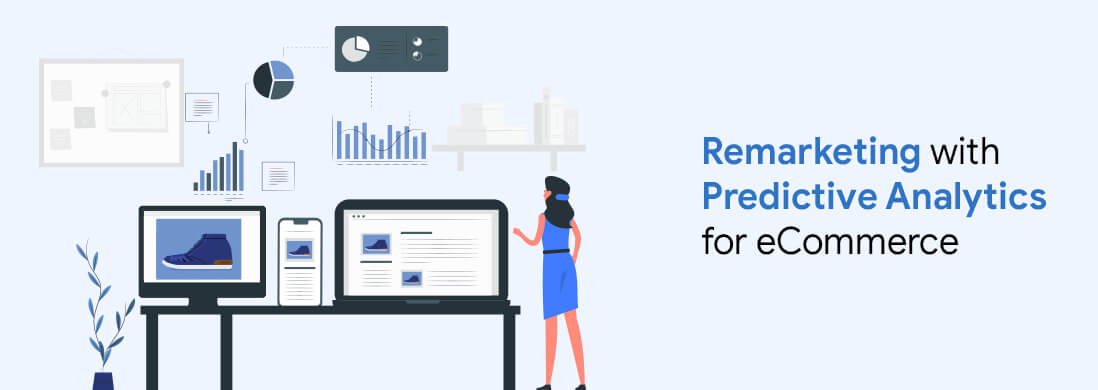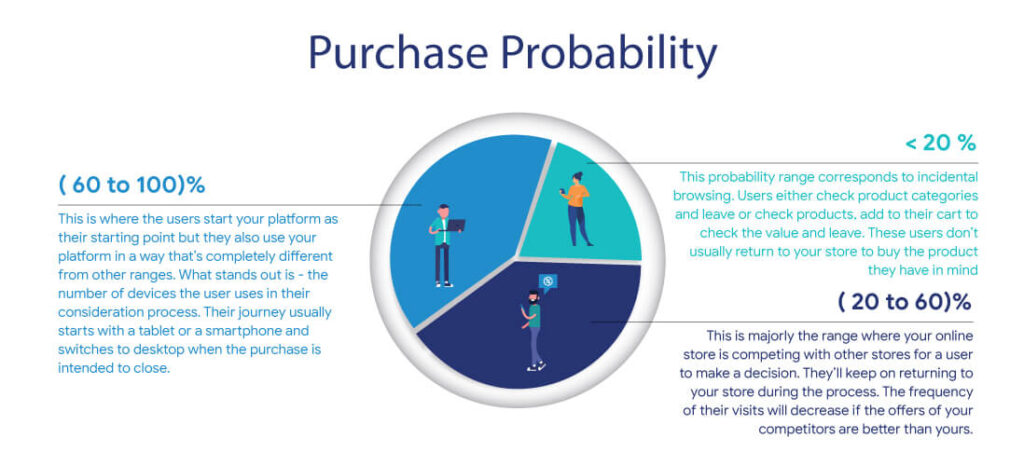Shopping is a habit. 87% of shoppers now begin their hunt in digital channels while the others start with the search engine. These habits don’t guarantee that they’ll end up buying from the website where they started. Over 30% of people visit two or more stores during their buying journey.
Shoppers visit other stores because they want a better selection, product availability, better info or shipping options. Remarketing leverages these touchpoints to motivate these shoppers to break the pattern of their habits and consider whatever you’re offering.
A remarketing campaign showcases advertisements to people who’ve visited your website at least once. It works by tagging your users with data – a cookie that contains details about the visits on your website and the products they’re viewing. This cookie then triggers advertisements on other websites. This is where e-commerce predictive data analytics plays a key role. It helps deliver highly targeted remarketing ads that are more likely to convert by analyzing user behavior patterns.
Why know your prospect’s purchase probability?
Many studies have pointed out to the fact that remarketing campaigns are more effective, in conversions, when compared with email or search. Add an example of the study that you are mentioning here with proper citations..
The question is – At what cost? Not all people who visit your e-commerce website are genuinely interested in buying something. Your remarketing costs encompass all impressions and clicks of your visitors, with an alignment between CAC and LTV. Predicting consumer behaviour and then personalising banner ads will help with optimising your remarketing campaigns – a problem that’s difficult to get by segmenting your customer behaviour.
These predictions, when combined with machine learning capabilities, can help detect patterns in old data by looking for common points in the online behaviour of remarketed customers who’ve purchased something in the past 30 days. To understand the types of predictive patterns the algorithm is detecting, we’ll need to consider the shopping behaviour.
Understanding E-commerce Shopping habits
According to a Salesforce survey about users’ browsing and buying behaviour
- Half of the repeat buyers make their second purchase within 16 days of the initial purchase
- 87% of shoppers now begin their hunt on digital channels
- On average, mobile shopping sessions are 32% shorter than desktop sessions
- 64% percent of shoppers say they feel retailers don’t truly know them
- During the 2018 holiday season, the average order value increased by 14% when shoppers acted on AI-powered product recommendations
- 88% of retail and consumer goods marketers say personalization has improved their overall marketing program
These outcomes reveal significant insights into how customers are open to influence. This involves leveraging predictive data analytics, An effective remarketing strategy. An effective remarketing plan should be a balance between the consideration of your prospects, willingness to make rapid purchases, loyalty to your brand and the perceived value.
Knowing the Purchase Probability
The machine learning part is for detecting patterns with sell probabilities. A research states that – there is a direct relation between the purchase probability and the store or site activity. Below figure gives a bird’s eye view of behavioural patterns.
We did it!
One of our clients, who’s a mid sized fashion eCommerce retailer uses Facebook as their remarketing platform. This enables them to personalise advertisements by uploading their user list that’s segmented by interests when they crawled on your website. Just this setup helped our client generate a return on ad spend of about 15 percent and a conversion rate of almost 7 percent. We summarised that this figure could go further up if we filter out the users who have low probability of purchase. We then applied the detected probability patterns to the ongoing stream. Users who had more than 20 percent purchase probability were only included. This resulted in a rise by 4 percent in the ROI and 2 percent in the conversion rate.
With a significant increase in both ROI and conversion rate, the result highlights the use of predictive remarketing. This Facebook setup also helped us explore other ways of remarking. For instance, the platform offers lookalike audiences option. This audience comes with similar traits like gender, age, interests, among others
You can always remove the audiences with low probability of purchase, improving your conversion rate of marketing campaigns. While users with a very high purchase probability are convinced of your offers and products. Advertising them may turn out to be redundant, moreover, it can turn them off. Excluding them will help you control your ad budget while improving profitability.
Tatvic has developed a solution, PredictN, which has a predictive analytics framework that works on predictive machine learning model. It aims to generate Audience Segment (Qualified Visitors) that carries Highest Probability of Revisiting your site and getting Converted as a Customer within the next 7 days.
The objective is to facilitate predictive analysis for remarketing effectively to the Qualified Audience Segment only and get more conversions with the reduced marketing spend.
Predictive Analytics Solutions for E-commerce Businesses
Remarketing is one of the most effective ways for competing in the eCommerce space as long as your plan recognises the right target audience and consideration process. Our team can help you with insights about individual customer journeys, the products your prospects consider and the way in which they use their shopping cart.
Once you’ve balanced your remarketing strategy, it can now be actioned by creating display ads with the right pair of products. The prediction algorithm can help you disseminate these ads to the right audience. As we noticed with our client, implementing a prediction algorithm can help you with improving your CAC-LTV ratio.
Want to know more? We’ve got you covered. Contact us now to leverage the most effective predictive data analytics services!




